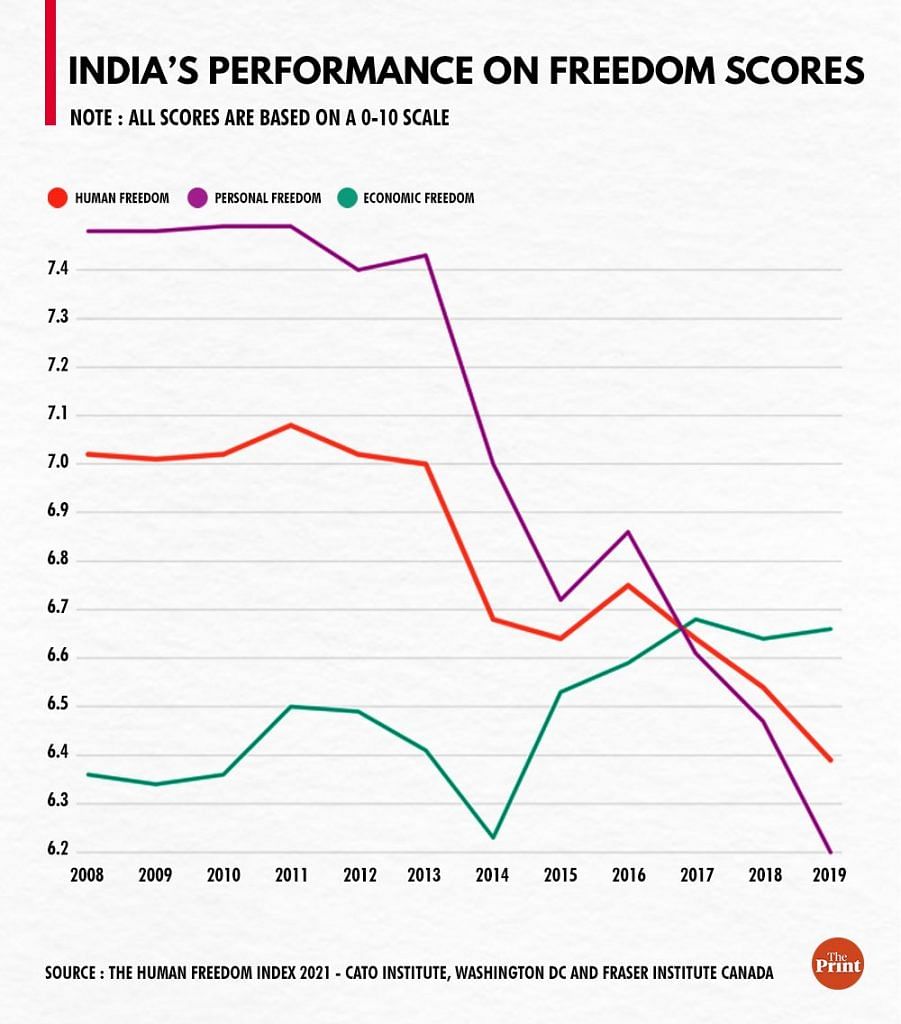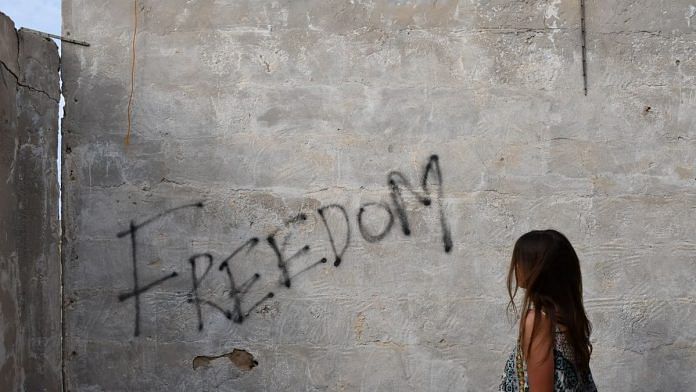New Delhi: India’s performance on various indicators of economic, personal, and civil freedoms was in near-constant decline between 2013 and 2019, this year’s Human Freedom Index report, released Thursday, has said. Based on data from 2019, India was ranked 119 out of 165 countries. It was ranked 90 out of 157 countries in 2013.
The data also showed that while India’s rank for “personal freedoms” has plummeted since 2013, its performance on “economic freedom” has improved, albeit marginally, in that period.
The 2021 report, co-published by two think tanks — Cato Institute in the US and the Fraser Institute in Canada — has used 82 indicators to rate countries from 2008 to 2019, which is the most recent year for which there was internationally comparable data.
India’s rank is better than its neighbours China (150), Pakistan (145), and Bangladesh (142), but it has fared worse than Nepal (84), Bhutan (98), and Sri Lanka (112).
According to the report, 83 per cent of the world has seen a decline in freedom between 2008 and 2019, representing “a disturbing trend” that preceded the Covid-19 pandemic and related restrictions.
Data from the report shows that the greatest falls around the world were in the areas of freedom of expression, freedom of religion, and freedom of association, assembly, and civil society. “We fully expect to see a deterioration in global freedom indicators in future reports,” the report said.
The report added that higher levels of freedom are associated with prosperity and well-being. Countries in the top quartile, the report said, have a much higher income per person ($48,748 or approx. Rs 37 lakh) than those in the bottom quartile ($11,259 or approx. Rs 8.6 lakh).
Also Read: India is now only ‘partly free’ — Freedom in the World report downgrades status
The India story — what changed?
Between 2008 and 2013, India ranked among the top 90 countries of the world in the Human Freedom Index.
Its rank was 90 in 2013, but 106 in 2014. In 2018, India’s rank was 114, and it reached its all-time low so far at 119 in 2019. Referring to the plummeting rankings of India, Hungary, and Venezuela, the report said that the data showed “the effects of various forms of populist rule on overall freedom”.

A deeper look at the statistics along the two broad parameters of personal and economic freedoms shows some interesting trends.
Between 2013 and 2019, India’s rank on the personal freedom index has slipped to 119 from 85.
The parameter of “personal freedom” covers a number of indicators, including rule of law, security and safety, freedom of movement, freedom of religion, freedom of assembly, freedom of the press, and various freedoms to exercise choice in personal life such as same-sex relationships and divorce.
In this broad category, India recorded a heavy deterioration in the indicator “government efforts to censor”. This particular statistic was derived from Sweden-based think tank V-Dem Institute’s ‘Varieties of Democracy’ measurement.
All scores were scaled to 10. Prior to 2014, India scored 8.6 on average for this particular indicator, but in the 2014-19 period it came down to 5.2. For 2019, this score came down to 4.1.
Similarly, the index recorded large deteriorations in civil society repression (8.2 average till 2013 to 5.5 by 2019), civil society entry and exit (6.2 to 3.9), freedom of religion (7.9 to 6.1), freedom of expression (9.3 to 7.7), and religious organisation suppression (8.6 to 6.6).
Some positive indicators
In economic freedoms, however, India improved marginally, with its rank rising to 108 in 2019, from 111 in 2013.
This parameter includes indicators like state ownership of assets, movement of capital and people, inflation, regulatory trade barriers, and also various factors related to the soundness of the legal system and property rights.
The data shows that economic freedoms improved in India when restrictions on certain activities were removed. Until 2014, India scored a 0 in terms of having the freedom to own a foreign currency bank account, but this jumped to 5 in 2015 (and has remained there since).
Similarly, the reduction of licensing restrictions has also had a positive impact. Between 2008 and 2014, India scored on average 4.62 for licensing restrictions, but from 2014 to 2019, this average score moved up to 8.62.
Human freedom and its links with prosperity
The report suggests that there is a “strong relationship” between the level of freedom and prosperity of a country.
The freest countries — including top-five performers Switzerland, New Zealand, Denmark, Estonia, and Ireland — enjoy more than double the average per capita income of those in the other quartiles.
While the report says this is not enough to suggest “causation”, it does raise the question of whether human freedom matters for development.
Region-wise analysis of the rankings shows that human freedom tends to be higher in North America and western Europe, with a greater prevalence of developed societies, than in Asia and Africa.
The authors maintain that civil liberties are interlinked with economic freedoms. Countries offering higher economic freedoms tend to have better personal freedom scores as well.
The report also mentions that human freedoms are positively associated with the level of democracy. Using the Economist Intelligence Unit’s ‘Democracy Index’, the report maintains that the better the democracy, the higher the personal freedom it offers.
“There is a strong correlation of 0.87 between freedom and democracy. The findings are not surprising, but they offer rich opportunities to empirically examine a complex relationship in which the direction of causation or support between the two variables, if any, may strengthen or weaken over time and may be influenced by numerous other factors, including the level of development,” the report said.
The report further pointed out that economic freedom “empowers individuals to exercise other freedoms” and reduces their dependence on governments and other forces in society that might “restrict liberty or attempt to centralise power”.
(Edited by Asavari Singh)
Also Read: These 5 journalists were killed in India in 2021. 4 ‘murdered’, 1 died on dangerous assignment






